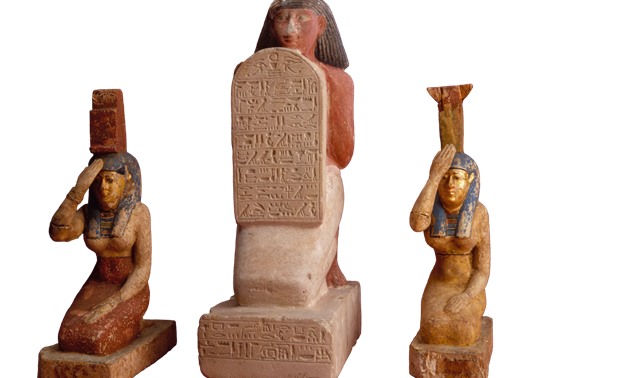
Ancient Egyptian Statues - Press photo
CAIRO - 5 January 2020: ET reveals details of the artifacts returned by Sheikh Sultan bin Muhammad al-Qasimi, Member of the Supreme Council and Ruler of Sharjah, to Egypt.The artifacts totaled up to 425 rare Egyptian artifacts from several eras.
The artifacts are returned to Egypt in a touch of love and appreciation from the new ruler of Sharjah to Egypt, which has played and still plays an active and vital educational and enlightening role in the Arab countries.
The history of the artifacts that reached Cairo coming from Sharjah, dates back to different time periods from the pre-fourth millennium B.C. ages, and different Pharaonic eras; The Ptolemaic Era from the fourth century to the first century BC, the Roman period from the first century BC to the second century AD and the Coptic era from the fourth to the sixth century AD.
The artifacts also include vitrified stone, porcelain, wood and bronze sculptures representing ancient Egyptian deities, in addition to wooden coffins decorated with colors, in addition to human and animal mummies; birds, fish, and necklaces and bracelets of precious stones. The artifacts also contain pendants, and animal models of hawks and fish made from alabaster and timber.
Sheikh Al-Qasimi, the ruler of Sharjah, is considered one of the biggest enthusiasts in Arab heritage and its preservation, believing in its historical importance and great value in enriching the heritage of all humanity.
Qasimi, upon his arrival at Cairo Airport in 2017, returned to Egypt a total of 354 artifacts that were seized and confiscated by the customs officers at Sharjah International Airport. It is a group of confiscated artifacts of great importance in their archaeological and historical value dating back to the Pharaonic period and some Islamic eras. The pieces included boxes containing pieces that have varied in its material, some of which were made of diorite stone, while other pieces were made of limestone, in addition to a group of copper and wooden artifacts.
Among the 354 artifacts returned to Egypt in 2017, were limestone slabs and a number of stone obelisks of various sizes containing hieroglyphic drawings and writings, in addition to black diorite statues, one of them resembling the famous Sphinx, and numerous Ushabtis , which were carved as servants of the deceased in their after-life journey, according to the prevailing belief in that period. The materials of the Ushabti statues varied, ranging from green faience, wood and pottery.
A large group of copper-encrusted eyes seized at Sharjah International Airport were also returned, in addition to a group of golden fingers and textile remains with pharaonic drawings. As for the Egyptian-Islamic artifacts, were two stone tablets and a glass disc bearing Islamic inscriptions.
Al-Qasimi was keen that the process of handing over the historical artifacts must be carried out under his personal supervision. It was received from the Egyptian side by representatives of the Egyptian Ministry of Antiquities who were present at Cairo International Airport upon his arrival on the afternoon of Jan. 5.

Comments
Leave a Comment